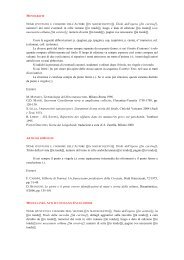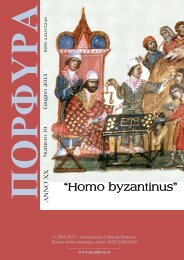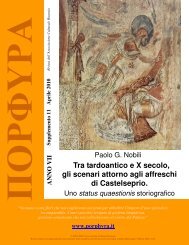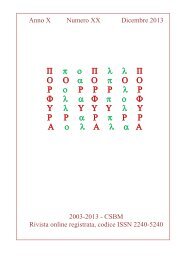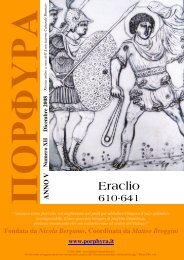ΠΟΡΦΥΡΑ - Porphyra
ΠΟΡΦΥΡΑ - Porphyra
ΠΟΡΦΥΡΑ - Porphyra
Create successful ePaper yourself
Turn your PDF publications into a flip-book with our unique Google optimized e-Paper software.
A Prôtospatharios, Magistros, and Strategos Autokrator of 11 th cent.<br />
the equipment of Georgios Maniakes and his army according to the Skylitzes Matritensis miniatures<br />
and other artistic sources of the middle Byzantine period.<br />
could be of leather, but we can not exclude the use of a mixture<br />
of coarse silk and cotton (κουκουλιον and βαµβακιον) or<br />
even felt by the cut of stripes of kavadia to form this kind of<br />
protection. 83<br />
The use in the East-Roman army of bossed pteryges is<br />
archaeologically suggested by a buckle from Sardinia, found in<br />
a cavalryman s’ grave of the 8 th century, where the owner of the<br />
buckle is shown falling from his horse : he is dressed with an<br />
undercuirass garment with bossed pteryges. 84 Of course this<br />
kind of protection should be hung from a metallic or leather<br />
bronze plated belt, because of the weight. The overall<br />
impression was in any case a metallic one 85 .<br />
On the upper arms he wears metallic bracelets, probably<br />
the Manikia mentioned in the sources 86 ; these are protective<br />
sections of the upper arm shaped like true armoured bracelets<br />
(fig.7 n. 7-8). It was an extension of the arm protection, as<br />
separated metallic scales pteryges-kremasmata forming an<br />
additional protection which the warrior fastened around the<br />
upper arm. These metallic µανικια are similar but bigger than<br />
those worn by Basil II in the miniature of Marcianus Gr.17., and<br />
can be seen in a lot of artistic subjects representing East-Roman<br />
83 This could help to explain also the difficult interpretation of the passage mentioned in Praecepta Militaria III, 8;<br />
cutting the καβαδιον in the form of old fashioned pteryges and so forming the protection from waist down gives as<br />
result κρεµασµατα which preserves the Roman aspect of the armour without excluding the practical protection,<br />
necessary for the cavalrymen with short klibania. The kavadion was a word used in medieval Greek of this age both to<br />
indicate a military garment which could be used alone, as undercuirass or overcuirass, composed by felt mixed with<br />
cotton, as well a Court Dress.<br />
As a garment, finding his apogee as Court Dress in the 14 th cent., was probably derived by the Sassanian Persian. The<br />
late Sassanian warriors of Piandjikent are represented wearing them it distinctively in the frescoes of 7-8 th century<br />
(Yakobovsky, Questions in the study of Piandjikent paintings, Moscow 1953, fig. 19-23, pl. XXXIII, in russian). It is<br />
so not improbable that the word comes from a garment used from the Persian Princes, called kabbade, as said by<br />
Tzetzes in his Commentarii Iliadis,2 and as confirmed by Kodinos, VI, who tells us as the Roman Emperors received,<br />
through Cyrus and then Alexander the Great, this dress from the Assyrians, i.e. from the Persians: "...and from the<br />
Lordship of the Medians received the phakiolion and l'epilorikion, from the Assyrians the skaranikon, the kabbadion<br />
and the flag dragon shaped...". - (Codinus Curopalates, De Officialibus, VI, p. 54 ; commentarii pp. 229-230).<br />
As military dress was a long one, shorter of the Court dress, composed by padded material doubled internally and<br />
externally, with or without sleeves, not folded and without hems, touching the calf, composed of doubled κεντουκλον<br />
which formed the thick body of the garment; when the body was closed by a belt, the movement of the legs reveals that<br />
the lower edges were folded by means of sewing on the internal hems. The soldiers wore it in battle if were lacking<br />
metal armour, even if the καβαδιον could well be worn under or over the κλιβανιον for a better body protection. See<br />
Sylloge Tacticorum, 38, 4 ; 38, 7 . This fasten again to his function, in successive ages, of overgarment. So Tzetzes in<br />
the above over mentioned passage: "...The battle dress, the garment cloak of the soldiers, just called καβαδηs from the<br />
Persian kabbade ...".About it see also Kolias, Waffen, pp. 55-56 ; Dawson, Kremasmata, 39-42 ; Kondakov P. N., Les<br />
costumes orientaux à la cour byzantine, in Byzantion, 1, 1924, 7-49.<br />
84 Cfr. Lilliu G., Milizie in Sardegna durante l’età bizantina, in Sardegna, Mediterraneo ed Atlantico tra medioevo ed<br />
età moderna, Roma 1993 p. 105-136, p. 133 ; and Caprara R., Reperti metallici altomedievali in AA.VV. Sardegna<br />
centro-orientale dal neolitico alla fine del mondo antico, Sassari 1978, 209-221, pl.LXXXVI.<br />
85 See Laszlo G., Etudes Archéologiques sur la societé des Avares, Budapest 1955, pp. 265-269 where the author<br />
shows plates of East-Roman and Avarian belts from the 6 th – 7 th centuries, which were probably produced by East-<br />
Roman workshops from the same mould used to do the metallic applications of the cuirass pteryges-kremasmata.<br />
86 See for instance Digenis Akritas, VI, 158, p. 153, where the hero, after a battle, comes back to his beloved taking off<br />
his weapons, i.e. shield, sword and arm protection.<br />
18



